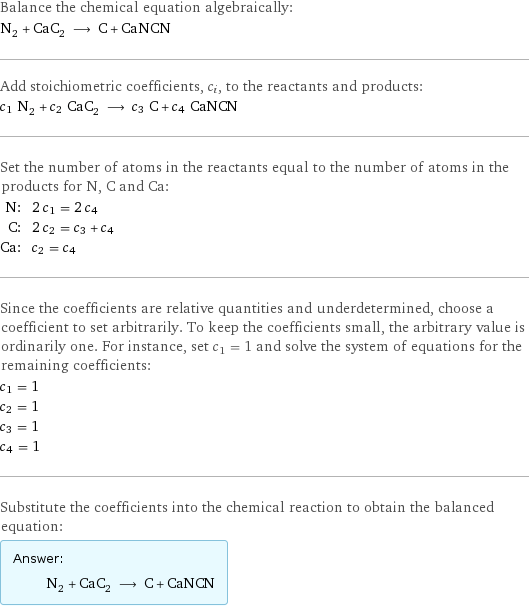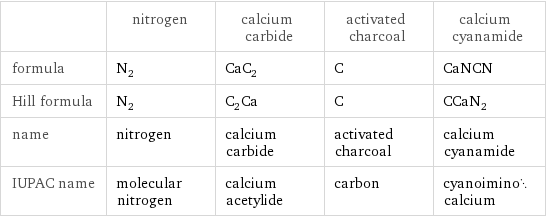Input interpretation

N_2 (nitrogen) + CaC_2 (calcium carbide) ⟶ C (activated charcoal) + CaNCN (calcium cyanamide)
Balanced equation

Balance the chemical equation algebraically: N_2 + CaC_2 ⟶ C + CaNCN Add stoichiometric coefficients, c_i, to the reactants and products: c_1 N_2 + c_2 CaC_2 ⟶ c_3 C + c_4 CaNCN Set the number of atoms in the reactants equal to the number of atoms in the products for N, C and Ca: N: | 2 c_1 = 2 c_4 C: | 2 c_2 = c_3 + c_4 Ca: | c_2 = c_4 Since the coefficients are relative quantities and underdetermined, choose a coefficient to set arbitrarily. To keep the coefficients small, the arbitrary value is ordinarily one. For instance, set c_1 = 1 and solve the system of equations for the remaining coefficients: c_1 = 1 c_2 = 1 c_3 = 1 c_4 = 1 Substitute the coefficients into the chemical reaction to obtain the balanced equation: Answer: | | N_2 + CaC_2 ⟶ C + CaNCN
Structures

+ ⟶ +
Names

nitrogen + calcium carbide ⟶ activated charcoal + calcium cyanamide
Equilibrium constant
![K_c = ([C] [CaNCN])/([N2] [CaC2])](../image_source/1d3d4a385a03e8e493a10f1a7f9b8aca.png)
K_c = ([C] [CaNCN])/([N2] [CaC2])
Rate of reaction
![rate = -(Δ[N2])/(Δt) = -(Δ[CaC2])/(Δt) = (Δ[C])/(Δt) = (Δ[CaNCN])/(Δt) (assuming constant volume and no accumulation of intermediates or side products)](../image_source/db01fd70ee441f329d39dac23f8daa98.png)
rate = -(Δ[N2])/(Δt) = -(Δ[CaC2])/(Δt) = (Δ[C])/(Δt) = (Δ[CaNCN])/(Δt) (assuming constant volume and no accumulation of intermediates or side products)
Chemical names and formulas

| nitrogen | calcium carbide | activated charcoal | calcium cyanamide formula | N_2 | CaC_2 | C | CaNCN Hill formula | N_2 | C_2Ca | C | CCaN_2 name | nitrogen | calcium carbide | activated charcoal | calcium cyanamide IUPAC name | molecular nitrogen | calcium acetylide | carbon | cyanoiminocalcium
Substance properties

| nitrogen | calcium carbide | activated charcoal | calcium cyanamide molar mass | 28.014 g/mol | 64.1 g/mol | 12.011 g/mol | 80.103 g/mol phase | gas (at STP) | solid (at STP) | solid (at STP) | solid (at STP) melting point | -210 °C | 2300 °C | 3550 °C | 300 °C boiling point | -195.79 °C | | 4027 °C | density | 0.001251 g/cm^3 (at 0 °C) | 2.22 g/cm^3 | 2.26 g/cm^3 | solubility in water | insoluble | decomposes | insoluble | surface tension | 0.0066 N/m | | | dynamic viscosity | 1.78×10^-5 Pa s (at 25 °C) | | | odor | odorless | | | odorless
Units
